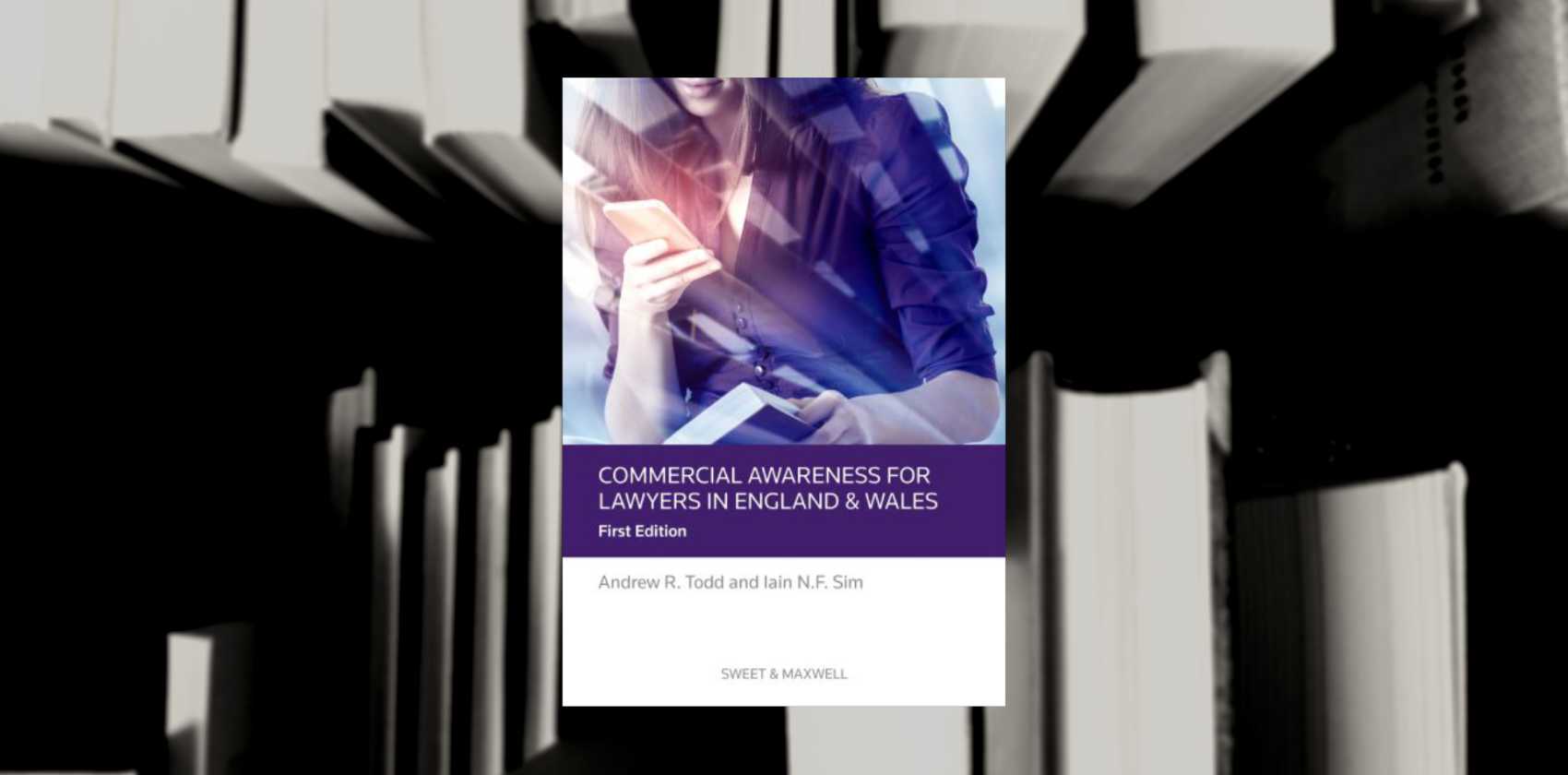
How to Keep the Lights On
“It’s Tuesday. You’re at your desk. The phone rings. It’s reception. A client wants to speak to a lawyer in your team. Your colleagues are in meetings and you’re the only one available to speak to the client. What do you do?”1Andrew R. Todd and Iain N.F. Sim, Commercial Awareness for Lawyers in England and Wales (Sweet & Maxwell, 2019) at p 23.
Like degrees in accounting, medicine and advertising, a law degree is a professional degree, as it prepares the holder for work in law. Under current legal education paradigms, law school “prepare[s] people to think like lawyers”, while law firms train them to become lawyers.2William Michael Treanor, Louis Michael Seidman, Robert A. Katzmann, Philip G. Schrag, Robin L. West, and Patricia D. White, “The Crisis in Legal Education”, American Academy of Arts and Sciences Spring 2016 Bulletin https://www.amacad.org/news/crisis-legal-education (accessed 21 February 2020). In the US, for example, the legal job market has been in the doldrums since the Great Recession3Staci Zaretsky. “Job Market For Law School Grads Is ‘Best Since The Recession,’ Bolstered By Biglaw Hiring”, Above the Law (2 August 2018) <https://abovethelaw.com/2018/08/job-market-for-law-school-grads-is-best-since-the-recession-bolstered-by-biglaw-hiring/> (accessed 21 February 2020). and law degrees can cost well above US$100,000.4Emma Kerr, “10 Most Expensive Law Schools”, US News (20 August 2019) <https://www.usnews.com/education/best-graduate-schools/the-short-list-grad-school/articles/most-expensive-law-schools> (accessed 21 February 2020). There have been calls from within the legal academy5Supra n 2. and from industry participants6Mark A. Cohen, “How Will Legal Education and Training Keep Pace With Change?”, Forbes (10 September 2018) <https://www.forbes.com/sites/markcohen1/2018/09/10/how-will-legal-education-and-training-keep-pace-with-change/#4250acfe7055> (accessed 21 February 2020). to reform law school curricula to impart business sense and other practical knowledge to law students so as to make them more “work ready”.7Neil J. Dilloff, “Law School Training: Bridging the Gap Between Legal Education and the Practice of Law”, (2013) 24 SLPR 2 at 427. This is especially pertinent since many US law firms lack the resources to train newly-minted lawyers. As one New York Times writer wryly observed, “graduates will need entrepreneurial skills, management ability, and some expertise in landing clients. They will need to know less about Contracts and more about contracts.”8David Segal, “What They Don’t Teach in Law School: Lawyering”, New York Times (19 November 2011) <https://www.nytimes.com/2011/11/20/business/after-law-school-associates-learn-to-be-lawyers.html> (accessed 21 February 2020).
In Singapore, becoming a lawyer is certainly harder than it used to be. The recent oversupply of law graduates9Siau Ming En, “The Big Read: As supply of lawyers lurches from shortage to glut, spotlight falls on policies”, Today (10 September 2016) <https://www.todayonline.com/singapore/big-read-supply-lawyers-lurches-shortage-glut-spotlight-falls-policies> (accessed 21 February 2020). coupled with shrinking firm profit margins have led to greater competition for training contracts, especially at more prestigious firms. Even with one foot in the door, trainees may then have to jostle with their peers for retention. After retention is offered, the “NQ” (newly-qualified) associate then has to shoulder the weighty expectation of being “work ready”.
But what exactly does it mean to be a “work ready” law graduate, and how can one attain this standard? The answer may be found in Andrew Todd’s and Iain Sim’s excellent guide for solicitors, Commercial Awareness for Lawyers in England & Wales (Sweet & Maxwell, 2019). Commercial Awareness for Lawyers in England & Wales was catered to students undertaking the “Business, Financial and Practice Awareness” learning outcome of the Diploma in Professional Legal Practice (the Scottish equivalent of Singapore’s Part B),10Wildy & Sons, “Commercial Awareness for Lawyers” <https://www.wildy.com/isbn/9780414055971/commercial-awareness-for-lawyers-paperback-w-green> (accessed 2 March 2020). and was later adapted for the English market. The book’s back cover describes it as an “essential reference text for students, trainees, and new lawyers” that “sets out clearly the necessary professional, client and business knowledge and skills required by the modern lawyer”. Being “work ready” means (among other things) having “commercial awareness”, which the authors describe as “a combination of professional, client and business knowledge and skills” and “knowing you are a lawyer who acts for clients, as part of a business.” Written in a straight-shooting and accessible style, this book is a rigorous exposition of these practical legal skills — what they are, why they are important, and how to develop them — to help the reader bridge the gap between law school and legal practice. In other words, this is a “work readiness” manual of sorts for those who have begun or are looking to begin their legal careers.
While the book is titled Commercial Awareness for Lawyers in England & Wales (emphasis added), the advice within its pages is equally relevant to lawyers in Singapore. The difference between academic legal knowledge and the lawyering skills expected of any competent lawyer, the authors note, is not unlike the difference between knowing the Highway Code and knowing how to drive;11Supra n 1 at p 3. the former is knowledge while the latter is the same knowledge translated into action.12Supra n 1 at pp xiv. Fortunately, like driving, lawyering skills can be taught and acquired with practice, practice, and more practice.
The book is divided into four parts – “Becoming a Lawyer” (Part 1), “Commercial Awareness, Knowledge and Skills” (Part 2), “Finance” (Part 3), and “The Future” (Part 4). The chapters in Part 1, “Becoming a Lawyer”, discuss what it means to be a lawyer and the lawyer’s place in the legal business ecosystem. Chapter 1 (“Becoming a Lawyer”) is recommended reading for law students who are exploring their internship options or are about to embark on their first internship. Here, readers will find guidance on legal career options,13Supra n 1 at pp 17- 20. applying for traineeships,14Supra n 1 at pp 5 – 7. and information on the roles that various staff play within a law firm.15Supra n 1 at pp 9 – 10. This chapter also describes non-traditional legal careers, including professional support lawyers and legal engineers, which may become viable alternatives for Singapore law graduates as the Singapore legal market matures.
The concluding section of Chapter 1 rounds off the remainder of Part 1. Aptly titled “Your Reputation: Personal Reputation”, this section discusses legal professional ethics and client relationships and stresses the importance of respect for one’s reputation.16Supra n 1 at pp 20– 21. Being respected goes hand-in-hand with playing fair, so engaging in sharp practice is bound to damage one’s reputation with clients (who will not want to hire the lawyer) and peers (who will not trust the lawyer).17Ibid. The authors emphasise the importance of this to trainees, who are urged to abide by the same professional standards as lawyers.18Supra n 1 at p 21. In Singapore, practice trainees are generally subject to the same disciplinary jurisdiction as practising lawyers under section 83(3) of the Legal Profession Act (Cap. 161). Chapter 3 (“Lawyers”) concerns the Solicitors Regulation Authority’s (“SRA”) Code of Conduct19Since replaced by the SRA Standards and Regulations which came into force on 25 November 2019. (the UK equivalent of Singapore’s Legal Profession (Professional Conduct) Rules 2015) and contains a common-sense introduction to professional ethics. Chapter 3 discusses professional ethics concepts (such as confidentiality, handling client money and referrals) with concrete illustrations instead of tedious explanations of SRA Code of Conduct provisions, making the chapter a useful primer on universal ethical principles. The chapter also contains helpful advice on practice fundamentals that junior lawyers may overlook, such as taking and recording instructions (“At all stages it’s also important that you record your instructions. Then if you’re ever asked to justify an action you have an email, letter or file note to cover it.”20Supra n 1 at pp 43.).
Chapters 2, 5, and 6 focus on the most important aspect of the legal business — client relationships. Emphasising that law firms are ultimately a business, Chapter 5 explains how law firms sell a service (information translated into actionable advice) to consumers (clients),21Supra n 1 at p 93. and how firms market themselves to their desired audiences through market segmentation and branding campaigns.22Supra n 1 at pp 96 – 104. Chapter 6 outlines how young lawyers can get started on the daunting but all-important task of growing their own client base through networking. This, as the authors point out, boils down to meeting (the right) people, having a conversation, and keeping in touch afterwards (where appropriate).23Supra n 1 at p 108. The tips given here are helpfully specific. For example, the authors advise against reciting case law at interlocutors during networking events, while emphasising the importance of researching your target audience before the event, checking the news (for making small talk), and being a good listener.24Supra n 1 at pp 110 – 112. Of paramountcy is the advice on developing and preserving one’s professional reputation from day one – as the authors wisely note, “Once a client speaks to you… [t]hey’re judging you on your actions, words, advice and personality. It is up to you to protect and build your reputation, because it’s the one thing you carry throughout your entire career.”25Supra n 1 at p 107.
Part 2 (“Commercial Awareness, Knowledge and Skills”) contains chapters devoted to bread-and-butter skills that trainees and junior lawyers should acquire; these include report and correspondence writing (Chapter 7), holding client meetings (Chapter 8), negotiation (Chapter 9), billing (Chapter 11) and time management (Chapter 12). As before, the authors’ advice is delivered in a refreshingly pragmatic, punchy, and no-nonsense manner. For example, the authors’ advice on why answers to client questions must be front-loaded in written communications:
“Clients don’t want to wade through your thought processes to get to the answer. They’re shouting, ‘get to the point!’ If you’re ‘guilty’, you don’t want 10 pages telling you what happened. If your contract is unenforceable, you don’t want 20 pages debating it … Just be smarter about telling people what they want to know, first, and then tell them what they need to know (if they wish to read more).”26Supra n 1 at p 125.
Junior lawyers slightly further along in their careers will also find valuable advice in the chapters dealing with managerial and operational knowledge, such as fee setting (Chapter 10), delegating work (Chapter 13), team and project management (Chapter 14), risk management (Chapter 16), and designing legal services to improve the client experience (Chapter 17). While all these chapters are worthwhile reads, the chapters on delegating work and legal services design deserve special mention. In “How to Delegate Work”, the authors set out the rationale for delegating work, and give 12 tips for effective and meaningful delegation, including trenchant advice such as “If you’re delegating to avoid something you don’t like or don’t understand, then you shouldn’t be delegating it to someone else” and “Poor delegation is to say: ‘I want you to take this file and finish it off’”.27Supra n 1 at pp 190 – 191. Chapter 17, “How to Design Legal Services”, is noteworthy for its discussion on how the management concept of a “blueprint” can be used to improve the client’s experience. In the context of legal services, a “blueprint” is a document that identifies the elements of a lawyer’s work that are seen or experienced by the client (e.g. a drafted contract), as opposed to the elements that are hidden from view (e.g. phone calls with third parties).28Supra n 1 at pp 235 – 236. By reviewing their blueprints, lawyers can improve client satisfaction by auditing and innovating their work product with the client’s perspective in mind, and appropriately communicate to the client how the work product is prepared “backstage”.29Supra n 1 at pp 237 – 240. The book’s coverage of business and management topics does much to emphasise that there is more to legal practice than correctly applying the law to the facts.
In keeping with its focus on the commercial aspects of legal practice, Part 3 (“Finance”) covers the reading of financial accounts (Chapter 19) and managing a firm’s cash (Chapter 20). While these chapters appear to benefit those aspiring towards partnership, commercial lawyers in general will find useful introductions to reading financial statements and understanding how businesses operate, among others.
Conclusion
As the authors observe in the Introduction, money pays for essentials – rent, salary, electricity, phone lines, computers30Supra n 1 at pp xiii. – without which lawyers cannot pick up the phone to advise their clients. Commercial Awareness for Lawyers in England and Wales, with its unapologetically commercial focus on the skills needed for one to earn a living as a lawyer, is a significant contribution to the modern legal education syllabus. It is a must-read for anyone considering a career as a practising lawyer in today’s fast-changing legal industry.
While some chapters contain more UK-specific subject matter than the others, such as Chapter 3 (on professional ethics) and Chapter 18 (on personal finances and the financial services ecosystem), the basic concepts covered in these chapters are readily transferable to the Singapore context. However, what is lacking is litigation-specific advice in chapters where one might expect to find it, such as risk management and project management. Further, the topics on legal technology covered in Part 4 (“The Future”) may become outdated as technologies and their uses evolve from year to year. However, these minor issues do not detract from what is ultimately an enormously useful introduction for all lawyers, including those practising in Singapore, to the multifaceted nature and reality of a modern and globalised legal practice.
Endnotes
| ↑1 | Andrew R. Todd and Iain N.F. Sim, Commercial Awareness for Lawyers in England and Wales (Sweet & Maxwell, 2019) at p 23. |
|---|---|
| ↑2 | William Michael Treanor, Louis Michael Seidman, Robert A. Katzmann, Philip G. Schrag, Robin L. West, and Patricia D. White, “The Crisis in Legal Education”, American Academy of Arts and Sciences Spring 2016 Bulletin https://www.amacad.org/news/crisis-legal-education (accessed 21 February 2020). |
| ↑3 | Staci Zaretsky. “Job Market For Law School Grads Is ‘Best Since The Recession,’ Bolstered By Biglaw Hiring”, Above the Law (2 August 2018) <https://abovethelaw.com/2018/08/job-market-for-law-school-grads-is-best-since-the-recession-bolstered-by-biglaw-hiring/> (accessed 21 February 2020). |
| ↑4 | Emma Kerr, “10 Most Expensive Law Schools”, US News (20 August 2019) <https://www.usnews.com/education/best-graduate-schools/the-short-list-grad-school/articles/most-expensive-law-schools> (accessed 21 February 2020). |
| ↑5 | Supra n 2. |
| ↑6 | Mark A. Cohen, “How Will Legal Education and Training Keep Pace With Change?”, Forbes (10 September 2018) <https://www.forbes.com/sites/markcohen1/2018/09/10/how-will-legal-education-and-training-keep-pace-with-change/#4250acfe7055> (accessed 21 February 2020). |
| ↑7 | Neil J. Dilloff, “Law School Training: Bridging the Gap Between Legal Education and the Practice of Law”, (2013) 24 SLPR 2 at 427. |
| ↑8 | David Segal, “What They Don’t Teach in Law School: Lawyering”, New York Times (19 November 2011) <https://www.nytimes.com/2011/11/20/business/after-law-school-associates-learn-to-be-lawyers.html> (accessed 21 February 2020). |
| ↑9 | Siau Ming En, “The Big Read: As supply of lawyers lurches from shortage to glut, spotlight falls on policies”, Today (10 September 2016) <https://www.todayonline.com/singapore/big-read-supply-lawyers-lurches-shortage-glut-spotlight-falls-policies> (accessed 21 February 2020). |
| ↑10 | Wildy & Sons, “Commercial Awareness for Lawyers” <https://www.wildy.com/isbn/9780414055971/commercial-awareness-for-lawyers-paperback-w-green> (accessed 2 March 2020). |
| ↑11 | Supra n 1 at p 3. |
| ↑12 | Supra n 1 at pp xiv. |
| ↑13 | Supra n 1 at pp 17- 20. |
| ↑14 | Supra n 1 at pp 5 – 7. |
| ↑15 | Supra n 1 at pp 9 – 10. |
| ↑16 | Supra n 1 at pp 20– 21. |
| ↑17 | Ibid. |
| ↑18 | Supra n 1 at p 21. In Singapore, practice trainees are generally subject to the same disciplinary jurisdiction as practising lawyers under section 83(3) of the Legal Profession Act (Cap. 161). |
| ↑19 | Since replaced by the SRA Standards and Regulations which came into force on 25 November 2019. |
| ↑20 | Supra n 1 at pp 43. |
| ↑21 | Supra n 1 at p 93. |
| ↑22 | Supra n 1 at pp 96 – 104. |
| ↑23 | Supra n 1 at p 108. |
| ↑24 | Supra n 1 at pp 110 – 112. |
| ↑25 | Supra n 1 at p 107. |
| ↑26 | Supra n 1 at p 125. |
| ↑27 | Supra n 1 at pp 190 – 191. |
| ↑28 | Supra n 1 at pp 235 – 236. |
| ↑29 | Supra n 1 at pp 237 – 240. |
| ↑30 | Supra n 1 at pp xiii. |






